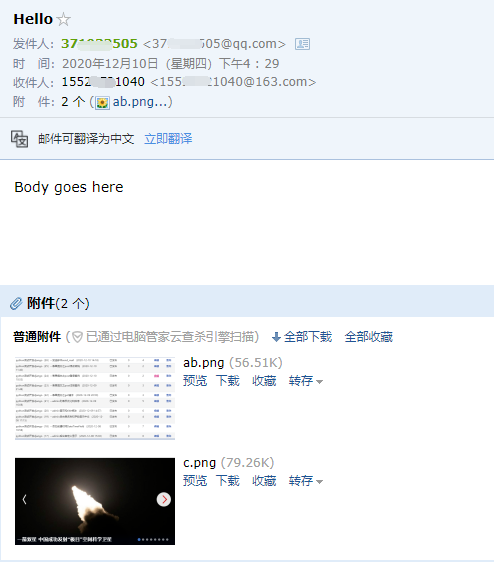标签:tip str blank mamicode src 扩展 pos 指定 上传
Django的send_mail()和send_mass_mail()函数事实上是对EmailMessage类使用方式的一个轻度封装。send_mail()和相关的其他封装函数并没有充分使用EmailMessage类的所有特性。
要想使用更多特性,比如暗送(BCC),加入附件,或是多用途格式(multi-part)邮件,都要直接创建EmailMessage实例。
有些资料用的EmailMultiAlternatives类,有些用的EmailMessage类,这2个其实有关联,EmailMultiAlternatives类继承了EmailMessage类
EmailMessage类使用下列参数初始化(除非使用位置参数,否则默认顺序如下)。所有参数均可选,均可在调用send()方法之前的任何时间对其赋值。
class EmailMessage:
"""A container for email information."""
content_subtype = ‘plain‘
mixed_subtype = ‘mixed‘
encoding = None # None => use settings default
def __init__(self, subject=‘‘, body=‘‘, from_email=None, to=None, bcc=None,
connection=None, attachments=None, headers=None, cc=None,
reply_to=None):
...省略
def send(self,fail_silently=False) :
"""
发送邮件报文。如果在构造邮件时如果指定了某个链接(connection),就会使用该链接发邮件。 否则,就会使用默认后端的实例发邮件。
如果关键字参数 fail_silently 为 True ,就会忽略邮件发送时抛出的异常。
"""
def recipients(self):
"""
返回邮件中所有收件人的列表,不管收件人是在 to 还是 bcc 属性中。
这是另一个经常被继承覆写的方法, 因为SMTP服务器在发送邮件报文时,要接收完整的收件人列表。
即使你自己的类使用其他方式来指定收件人,也仍然需要使用该方法返回收件人列表。
"""
def message(self) :
"""
构造了一个 django.core.mail.SafeMIMEText 对象 (Python的 email.MIMEText.MIMEText 类的子类) 或是 django.core.mail.SafeMIMEMultipart 对象(该对象保存即将发送出去邮件报文)。
如需扩展 EmailMessage类,一般情况下要覆写该方法,将你所需的内容添加到MIME对象中。
"""
def attach(self, filename=None, content=None, mimetype=None):
"""
传递一个单独的 email.MIMEBase.MIMEBase 实例做为参数。该实例会直接添加到最终的邮件报文中。
或者,给 attach() 传递三个参数: filename, content 和 mimetype. filename 是出现在邮件中的附件文件的名称, content 是附件的内容,而 mimetype 是附件所使用的MIME类型。
如果忽略 mimetype, Django会自动根据附件文件名来推测MIME内容类型。
例如:
message.attach(‘design.png‘, img_data, ‘image/png‘)
"""
def attach_file(self, path, mimetype=None):
"""
使用当前文件系统下的某个文件做为附件。调用时,传入某个文件的完整路径,以及该附件的MIME类型(可选的)。
忽略MIME类型的话,Django会自动根据附件文件名来推测MIME类型。
最简单的用法如下:
message.attach_file(‘/images/weather_map.png‘)
"""
使用当前文件系统下的某个文件作为附件。调用时,传入某个文件的完整路径,这种方法是最简单的,上传本地的某个文件。
如在templates目录下有一个a.png的图片(图片和其它文件都一样,如xx.doc,只是后缀不一样)
views.py文件实现代码
#coding:utf-8
from django.http import HttpResponse
from django.core.mail import EmailMessage
import os
def file_mail(request):
‘‘‘发送附件‘‘‘
email = EmailMessage(
‘Hello‘,
‘Body goes here‘,
‘3713505@qq.com‘, # 发件人
[‘15521040@163.com‘], # 收件人
[‘3719505@qq.com‘], # cc抄送
reply_to=[‘3719505@qq.com‘], # “回复”标题中使用的收件人地址列表或元组
headers={‘Message-ID‘: ‘foo‘},
)
cur = os.path.dirname(os.path.realpath(__file__))
# templates目录下有个a.png的图片
filepath = os.path.join(cur, "templates", "ab.png")
email.attach_file(filepath, mimetype=None)
email.send()
return HttpResponse(‘邮件发送成功,收不到就去垃圾箱找找吧!‘)
邮件收到效果如下

attach() 传递三个参数:filename,content和mimetype。filename是出现在邮件中的附件文件的名称,content是附件的内容,而mimetype是附件所使用的MIME类型。
参考格式如:message.attach(‘a.png‘,img_data,‘image/png‘)
#coding:utf-8
from django.http import HttpResponse
from django.core.mail import EmailMessage
import os
def file_mail(request):
‘‘‘发送附件‘‘‘
email = EmailMessage(
‘Hello‘,
‘Body goes here‘,
‘3733505@qq.com‘, # 发件人
[‘15521040@163.com‘], # 收件人
[‘3733505@qq.com‘], # cc抄送
reply_to=[‘15521040@163.com‘], # “回复”标题中使用的收件人地址列表或元组
headers={‘Message-ID‘: ‘foo‘},
)
cur = os.path.dirname(os.path.realpath(__file__))
# templates目录下有个a.png的图片
filepath = os.path.join(cur, "templates", "ab.png")
#方法1 attach_file
email.attach_file(filepath, mimetype=None)
#方法2 attach
filepath1=os.path.join(cur,"templates","c.png")
img_datas=open(filepath1,"rb")
email.attach(‘c.png‘,img_datas.read(),‘image/png‘)
email.send()
return HttpResponse(‘邮件发送成功,收不到就去垃圾箱找找吧!‘)
邮件收到效果如下

这里虽然能添加附件了,但是如果正文想传html的正文内容,这个类里面没有封装对应方法,在EmailMultiAlternatives类里面有个attach_alternative方法可以实现该功能,接着往下看。
attach_alternative方法封装在EmailMultiAlternatives类里面,EmailMultiAlternatives类继承了EmailMessage类
class EmailMultiAlternatives(EmailMessage):
"""
继承EmailMessage 可以轻松发送multipart / alternative消息。 例如,包括文本的HTML和HTML版本变得更容易
"""
alternative_subtype = ‘alternative‘
def __init__(self, subject=‘‘, body=‘‘, from_email=None, to=None, bcc=None,
connection=None, attachments=None, headers=None, alternatives=None,
cc=None, reply_to=None):
"""
Initialize a single email message (which can be sent to multiple
recipients).
"""
super().__init__(
subject, body, from_email, to, bcc, connection, attachments,
headers, cc, reply_to,
)
self.alternatives = alternatives or []
def attach_alternative(self, content, mimetype):
"""Attach an alternative content representation."""
assert content is not None
assert mimetype is not None
self.alternatives.append((content, mimetype))
使用方法
#coding:utf-8
from django.http import HttpResponse
from django.core.mail import send_mail
from django.core.mail import send_mass_mail
from django.core.mail import EmailMessage
from django.core.mail import EmailMultiAlternatives
import os
def file_mail(request):
‘‘‘发送附件‘‘‘
email = EmailMultiAlternatives(
‘Hello‘,
‘Body goes here‘,
‘3733505@qq.com‘, # 发件人
[‘15721040@163.com‘], # 收件人
[‘373505@qq.com‘], # cc抄送
reply_to=[‘157721040@163.com‘], # “回复”标题中使用的收件人地址列表或元组
headers={‘Message-ID‘: ‘foo‘},
)
cur = os.path.dirname(os.path.realpath(__file__))
# templates目录下有个a.png的图片
filepath = os.path.join(cur, "templates", "ab.png")
#方法1 attach_file
email.attach_file(filepath, mimetype=None)
#方法2 attach
filepath1=os.path.join(cur,"templates","c.png")
img_datas=open(filepath1,"rb")
email.attach(‘c.png‘,img_datas.read(),‘image/png‘)
#添加html正文
h=‘‘‘
<!DOCTYPE HTML>
<html>
<head>
<meta charset="UTF-8">
<title>带图片的邮件</title>
</head>
<body>
<a href="https://i.cnblogs.com/posts?cateId=1633461" target="_blank">
<p>点图片进入jango文章列表<br>
<img src="https://mail.qq.com/cgi-bin/getqqicon?sid=y4qfcTC8aEOSW00S&uin=-2239048779&mode=newaddr&mailaddr=371933505%40qq.com" height="160" width="270" />
</p></a>
<p>
其它图片:<br>
<img src="http://www.w3school.com.cn/i/eg_chinarose.jpg" height=150 width=300/></p>
<p>请注意,插入动画图像的语法与插入普通图像的语法没有区别。</p>
</body>
</html>
‘‘‘
email.attach_alternative(content=h,mimetype=‘text/html‘)
email.send()
return HttpResponse(‘邮件发送成功,收不到就去垃圾箱找找吧!‘)
到这里邮件发送相关的功能都实现了

总的来说,一般推荐用EmailMultiAlternatives类,它继承了EmailMessage
python测试开发django(28)--发送附件EmailMessage
标签:tip str blank mamicode src 扩展 pos 指定 上传
原文地址:https://www.cnblogs.com/canglongdao/p/14115087.html